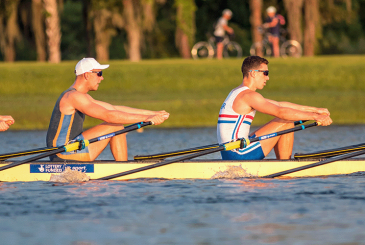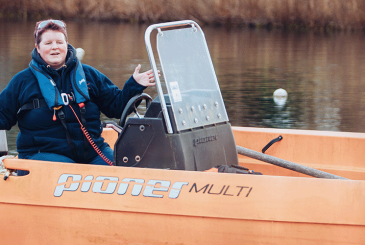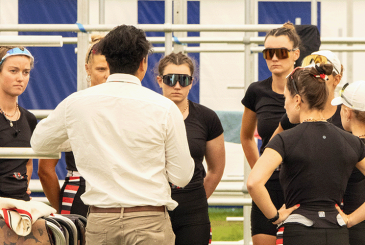Dan Harris has spent the last 10 years as coach of the World Class Start Centre in Bath and was head coach for the Great Britain team at the 2019 European Under-23 Championships. He shares five key factors in putting together a successful training programme
I’m not a physiologist, I’m a rowing coach. When I started out in coaching I did lots of research on concepts such as periodisation, but I also found that my own rowing journey was a really important source.
Textbooks can give you the ideal way to do things, but putting together a programme that athletes can do consistently with really good intent should be the main goal.
With that in mind, here are five things you should be thinking about when you put together a training programme.
Use your own experience
I still draw from my own experiences in rowing, first as a junior at St Leonard’s School in Durham, then as a coach while I was a student at the University of Bangor before starting my current role in Bath.
For example, my school crew all played rugby or football as well as rowing. I often work with athletes making a transition from other sports like football, rugby and swimming, so I need to account for different strengths.
I see it as pretty important that my juniors have more than just rowing. They have to choose to pursue rowing to a high level.
My university programme had no training programme – the focus was predominantly social. Writing a training programme made me think about planning for participation, alongside a few “performance-focused” individuals. You have to ask yourself who the programme is for and what they want out of it.
“The standards you set and the ethos you put in place is the sort of thing that may not be written down but can make a huge difference”
At Start in Bath, I’m responsible for the whole programme and athlete development, with multiple training programmes for athletes from the age of 14 up. I recruit athletes, work with complete novices – including those transitioning from other sports – and work with those aiming for GB selection at junior, under-23 and senior level.

Consistency and intent are key
There is no point in having a great-looking programme if no one does it, or no one does it to the right standard.
The standards you set and the ethos you put in place is the sort of thing that may not be written down but can make a huge difference.
For me, any structured training programme looks like a pyramid. The foundation is built by engaging athletes to ensure they are enjoying the sport, that they have squad and individual goals and that they are training with consistency and intent.
“I look to use training in the gym to establish our culture”
When novices are starting off with me, the rowing side is really technical, one stroke at a time. The fitness side is all done on the bike or running: there is very little rowing mileage. The ideal would be to do one stroke really well before building up one stroke at a time.
I want to prevent them from breaking down technically when they are new, but still to be able to train really hard, doing 60 to 90 minutes on the bike or going for a run.
I look to use training in the gym to establish our culture. Because everyone is together and it’s easier for everyone to communicate you can make the standards really clear. That can then follow through onto the erg and the water.
Start at the end then add structure
When putting a programme together, look at what you want to achieve and plan back from there.
Each athlete I work with has an individual development plan. That includes long-term targets – as students they might be looking to get into the GB senior team in six years’ time. There needs to be short-term targets, though, to get them to buy in and keep them motivated.
I have a yearly plan which highlights a few “gold events” such as Great Britain trials or perhaps a 2k ergo test. Silver events are national-level regattas, like the Henley regattas. Bronze events are local races or the Start camps that we have seven times a year.

From there I can look at intricacies such as periodisation. My programme has cycles lasting between six and eight weeks. There is a moderate week, a build-up week, four weeks that are pretty similar in terms of volume, and then there is a test and a reset.
Having a wave and flow of training allows athletes to recover, so there is always an awareness of the fluctuation in weeks and we never go more than about four weeks without having a light week.
We tested the theory almost unintentionally a couple of years ago when we felt we needed to do more mileage. It seemed to be going really well, but then there was a big crash, with injury niggles, a long period of fatigue and the plateauing of scores.
Looking back, we were doing too many sessions for too long.
A recovery week also works as a reset, doing lots of technical work. We might decide that for the next block we will work on a certain technical aspect. We start that in a recovery week before ramping back up again.

From there, there is a weekly plan, with what to do in each session and it’s important that it works for the athletes, fitting around work or lectures, and that they understand how it works.
In more detail still are the session objectives, which I break up into four areas:
1 – Aerobic – endurance work
Eg UT2 12-18km, UT1 40min rate 18-24 (using heart rate or splits based on testing to control intensity)
2 – Anaerobic – power endurance
Eg 30min rate 20 or intervals (3x2k, 4x1k, 10x500m)
3 – Technical – skill, drills, rate work, starts, force production
4 – Exposure – getting comfortable being uncomfortable
Eg 30min rate 20 followed by one minute max or “just row at a given split”
The aerobic and anaerobic sessions are the bread-and-butter sessions that you can record, but perhaps the more important sessions are the technical and exposure ones. I try not to get too caught up in them having a physiological outcome.
A technical session might be skills and drills but it could be 40 minutes of doing five strokes at a time, trying to move the boat as far as possible.
“Exposure sessions” are a bit different. Sometimes I don’t know what the impact will be other than that I am trying to put athletes under stress to help them get used to the unknown elements of competitive racing.
I might take a whistle on the water. They start when I blow the whistle and they don’t know when the piece is going to end.
Don’t be afraid to be flexible
I have an ideal programme, but nine times out of 10 it doesn’t end up like that.
Within my group of seven or eight athletes, I might have a set programme but three or four of them are doing something different.
“If someone has four exams in a week and they’re not sleeping, that training programme goes out of the window”
That might be because of injury, different goals that they are aiming for – more weights for strength or more cardio work to build fitness – or because they have demands outside of rowing that we need to consider.
An athlete might be struggling with an element of technique or an area of weakness in their physiology that needs to be addressed before you can make progress.
It’s also important to have an awareness of an athlete’s lifestyle and everything that is going on. If someone has four exams in a week and they’re not sleeping, that training programme goes out of the window. If they try to do the training they will probably end up ill or injured.
Make the most of competition
Athlete motivation and team dynamics have a massive impact on training outcomes. At the moment we have a really small group of six or seven athletes of all levels, but it is completely possible to have a relative novice pushing a GB triallist.
In the group we might use battle paddling in singles, giving a slower athlete a minute’s head start on a faster one.
I try to get the more experienced athletes to teach the others, perhaps going in a double with a novice. That helps develop their understanding and is a really good way to motivate the less experienced athlete and help their understanding.
Start camps offer the basis for a lot of our competition because of all the elements they include that you can prepare for, from race pieces to skills tests. We use all the skills, such as rigger-dips, hands off at the catch and half-slide suspension.
There are so many ways to assess development, whether that be skills tests, ergs and weights scores or core strength tests. A lot of that is available through British Rowing.
“I also believe you should not be afraid to seek feedback, from athletes and from other coaches”
At home, it’s important to have some set training tests than you can go back to. Through the winter, we do a long-distance time trial end-to-end on our river over 7.5km. We start at rate 24 then step up as the season goes on.
And finally, keep listening and learning
Below are a few books I use as regular references for the physiological aspects of the training programme. I look on YouTube a lot, looking at technique and physiology lectures, trying to find people who know more than me.
And I also believe you should not be afraid to seek feedback, from athletes and from other coaches, looking to understand what they do and why they do it. That way your programme will keep getting better.
Coaching webinar
Watch Dan’s talk in creating a great coaching programme from the British Rowing webinar season here.
Further reading
Periodization Training for Sports – Tudor O Bompa, Carlo Buzzichelli
High-Performance Training for Sports – David Joyce and Daniel Lewindon
Rowing Faster – Volker Nolte










